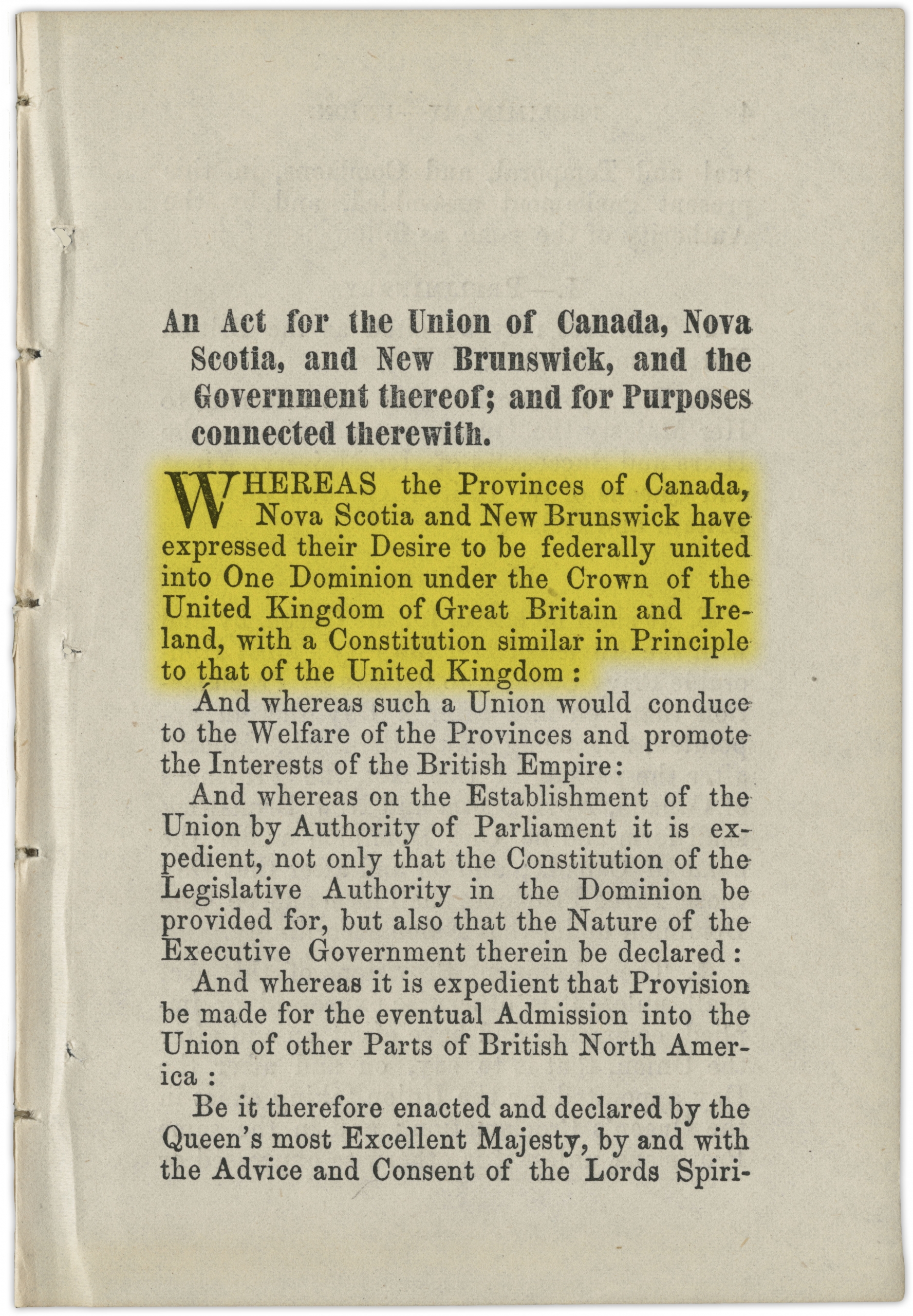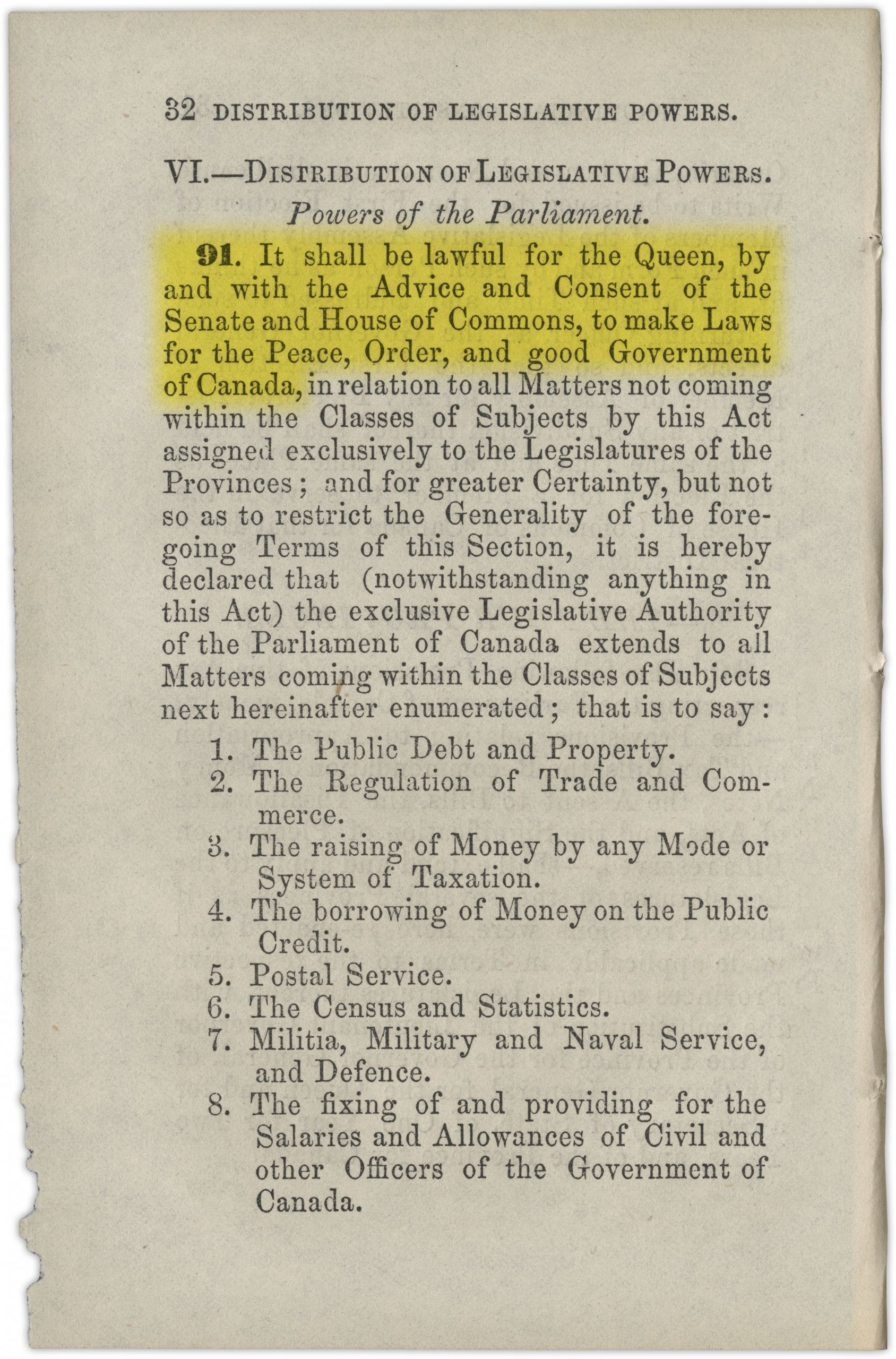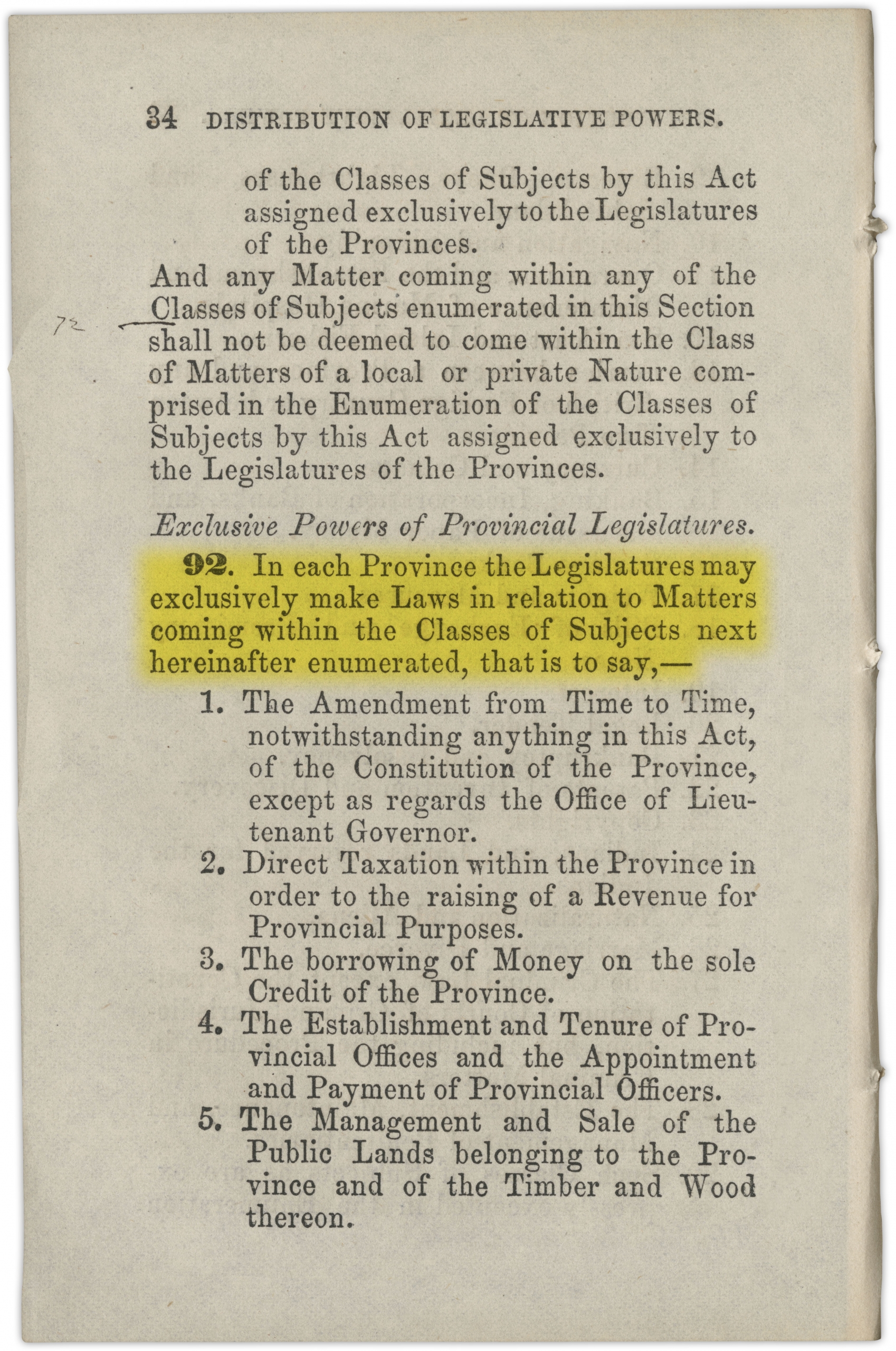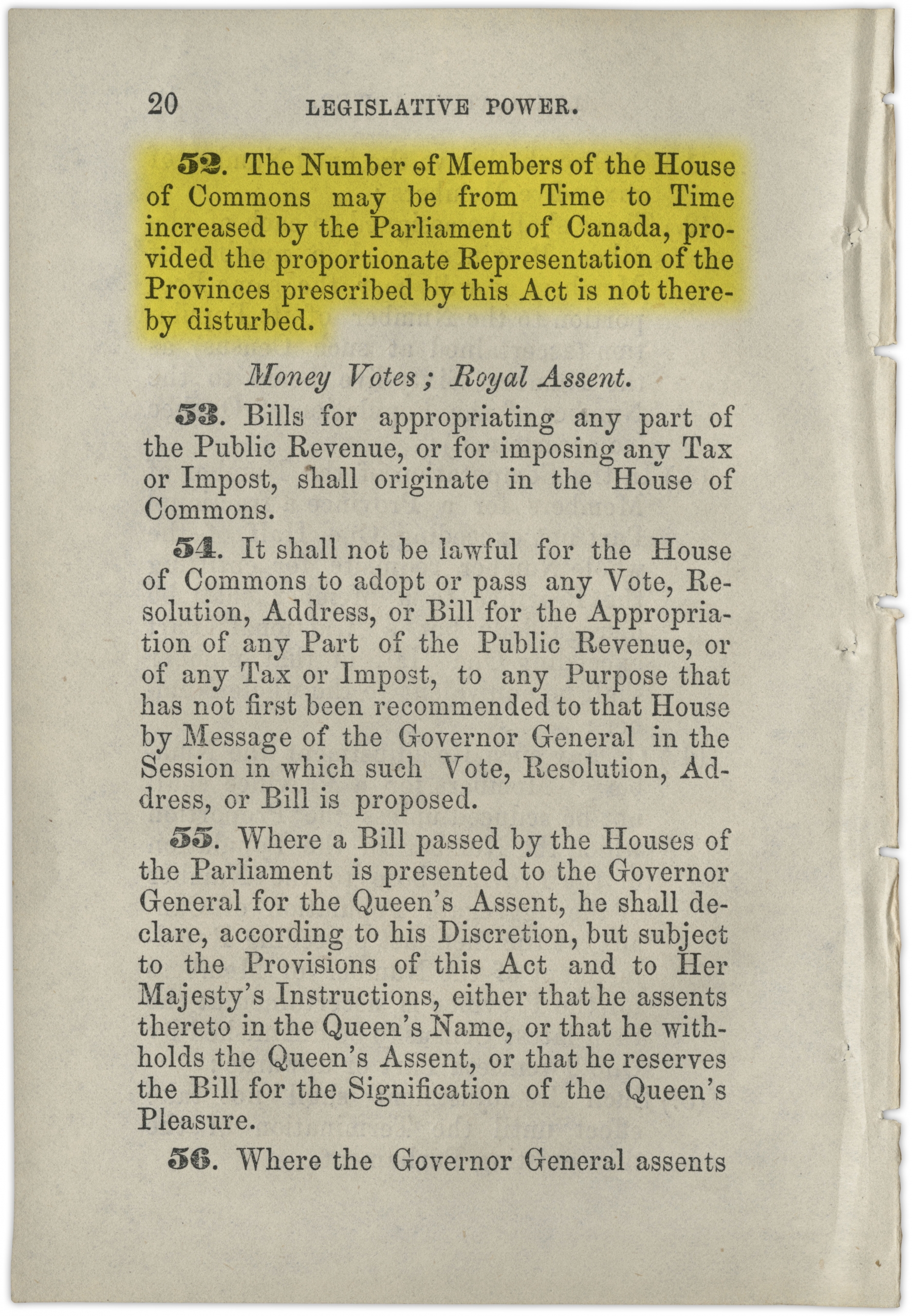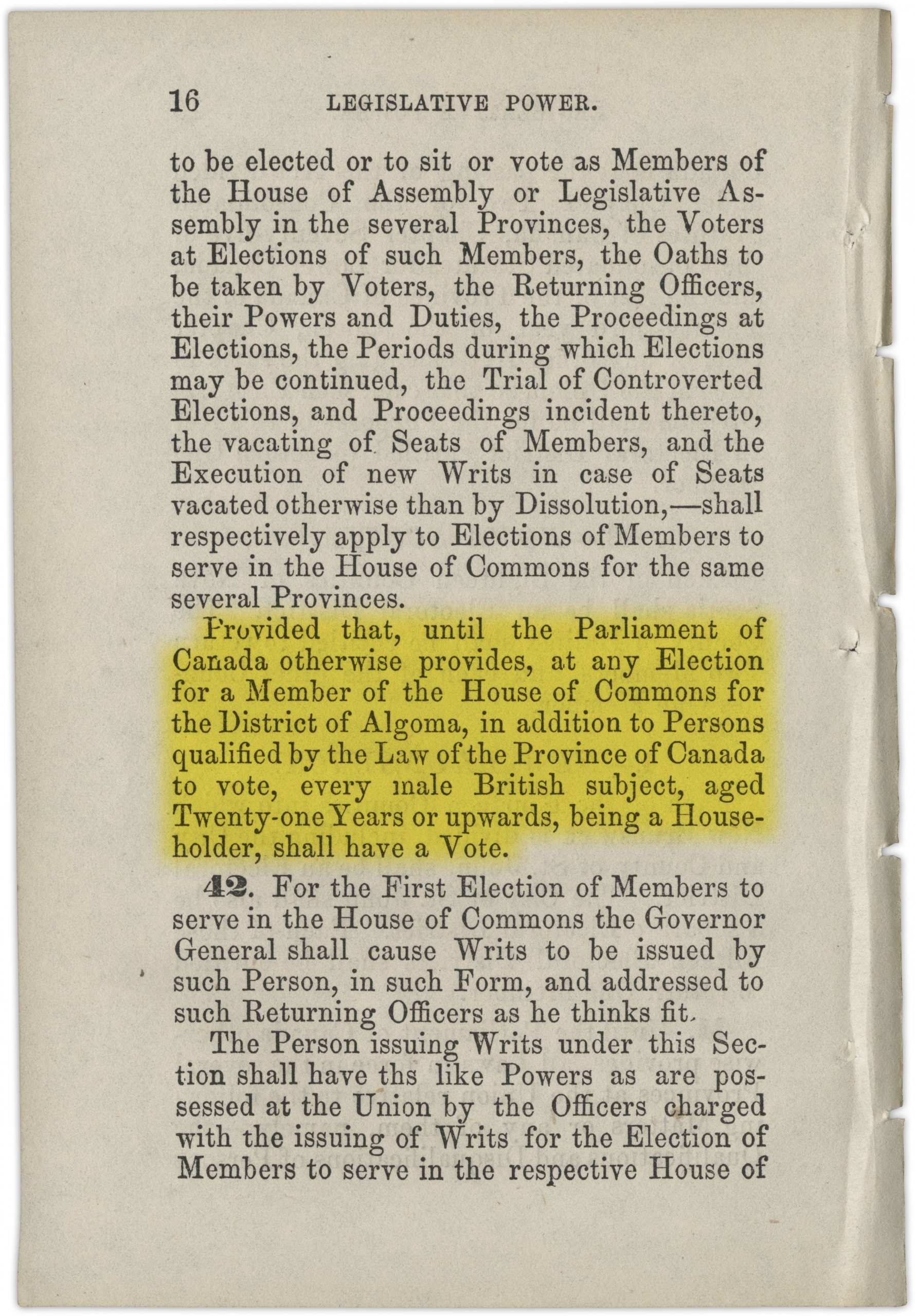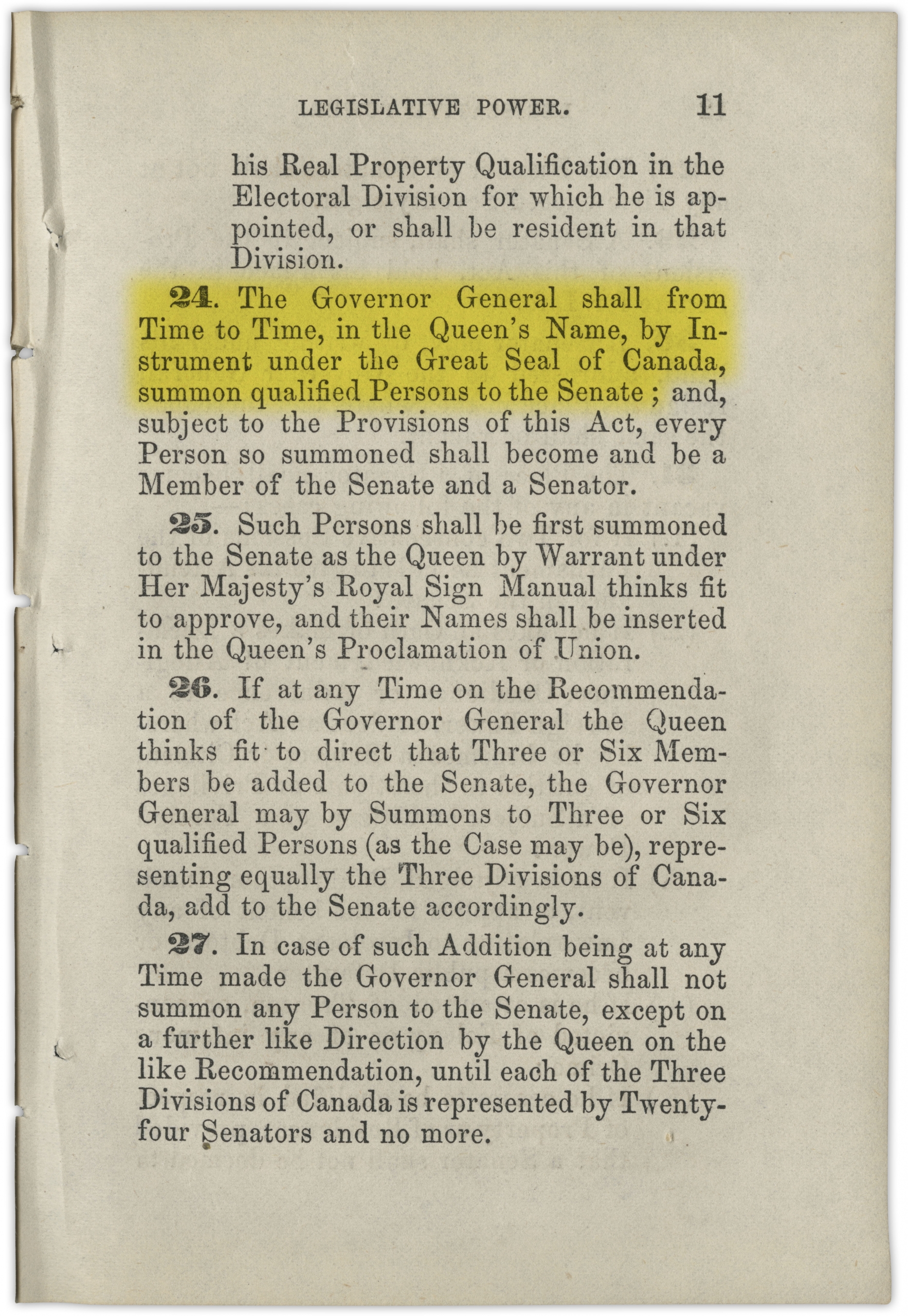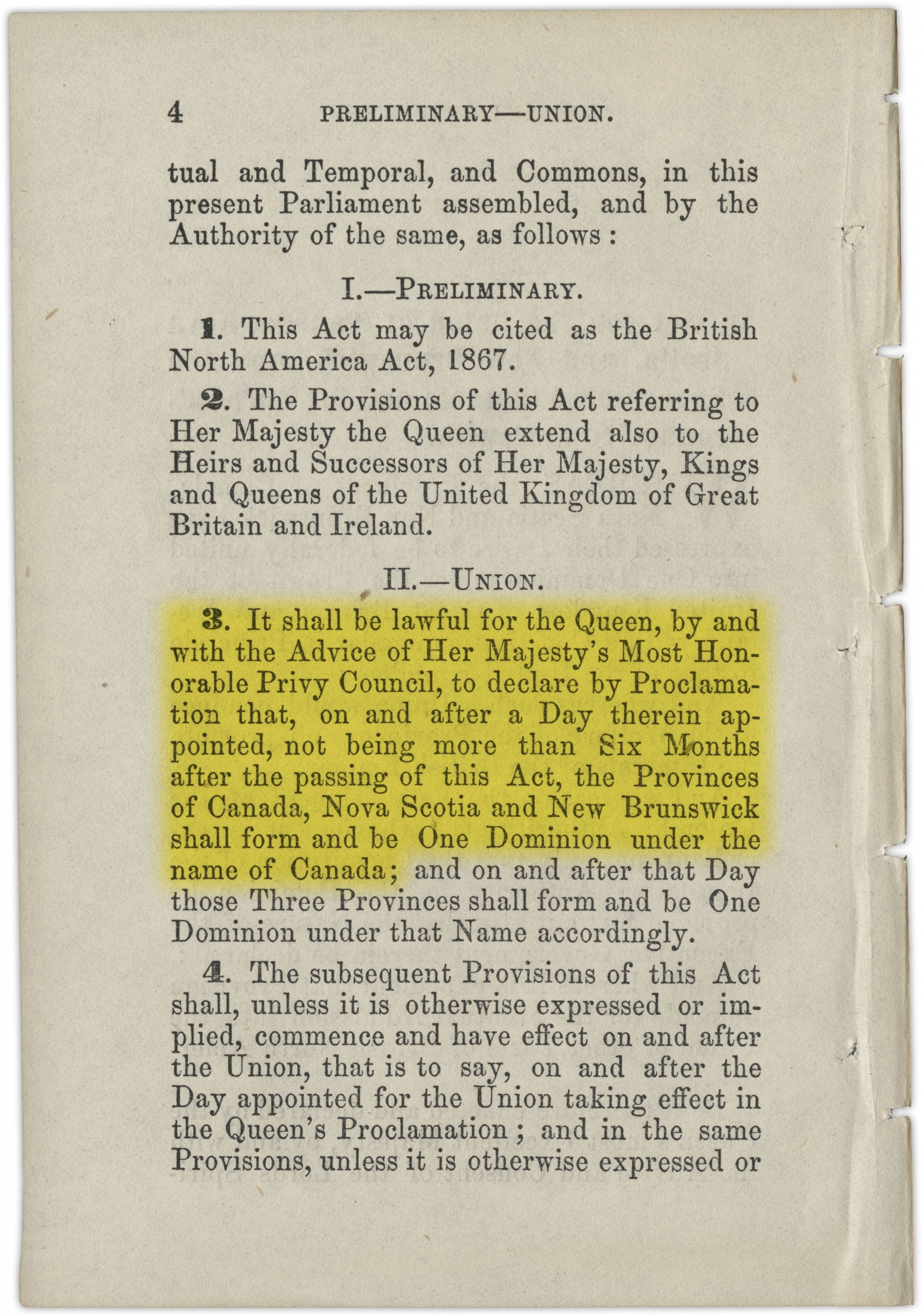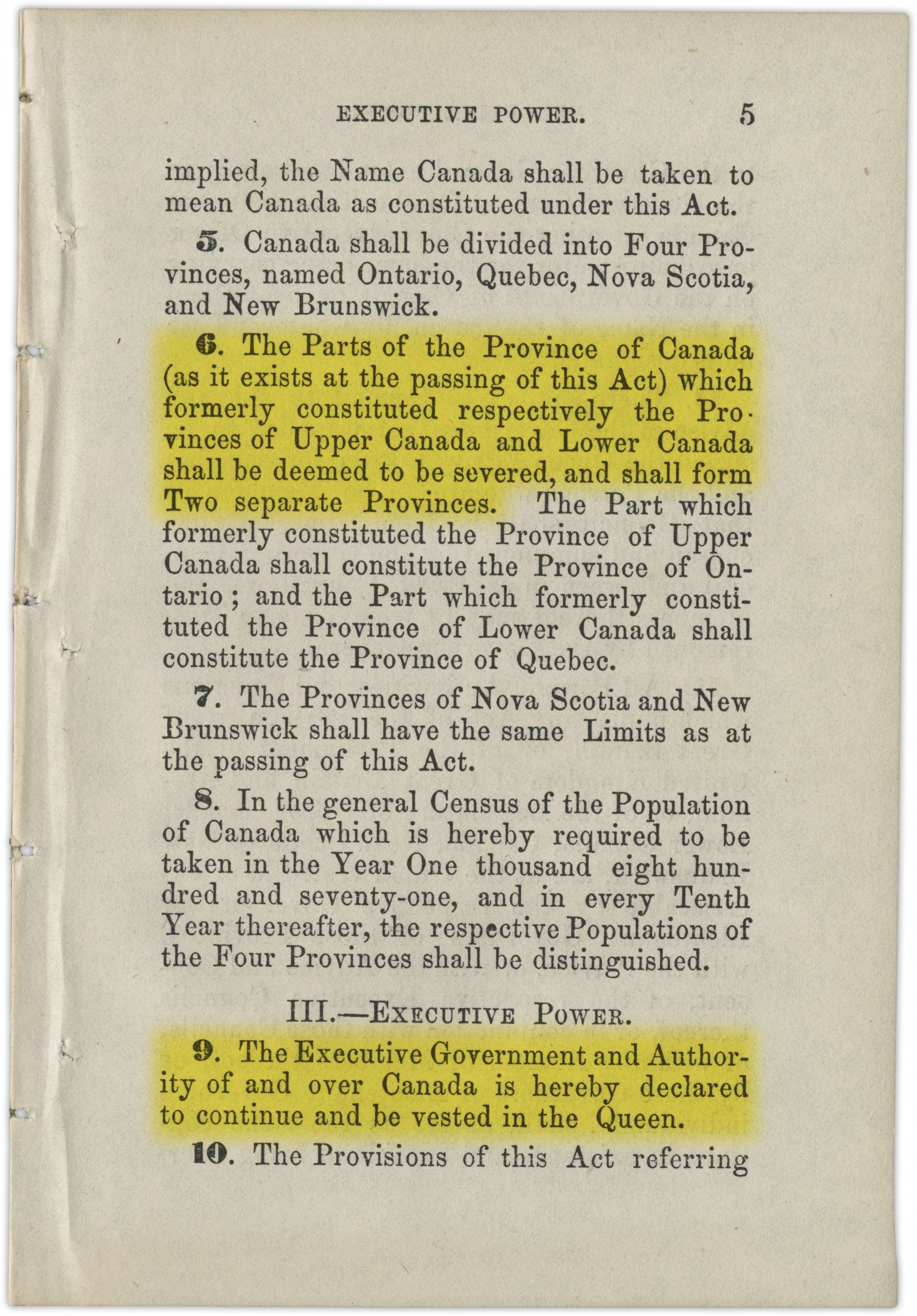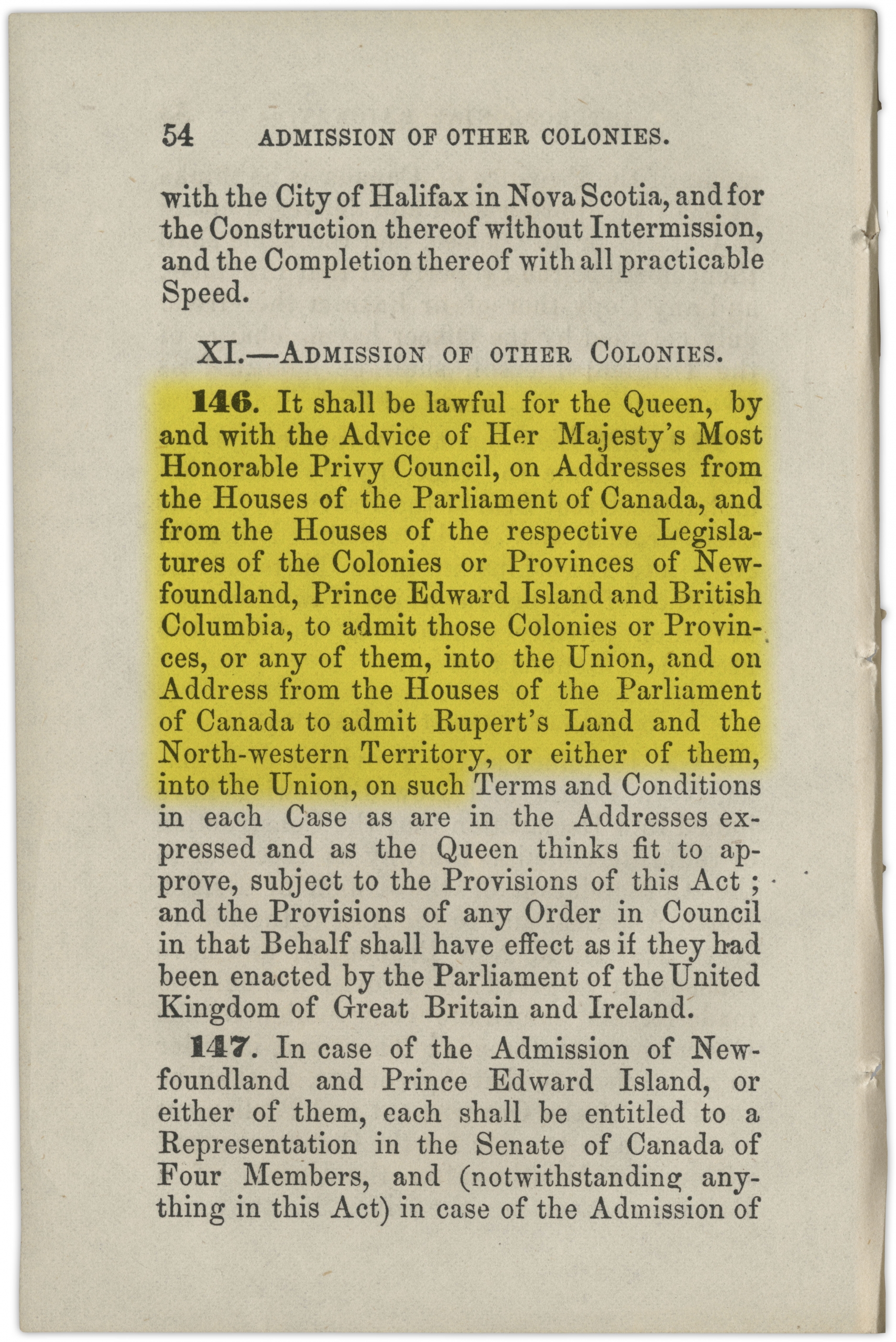British North America Act, 1867
Document
Image
Video
Audio
 Activities
Activities
LOOK
Read the document’s 10 key points (find them in the transcript section below). What are the main ideas in each one? Summarize these ideas in a few words, and present your work to a friend.
THINK
Sir John A. Macdonald wanted to create a powerful central government in which the majority of power would be held by a federal parliament rather than the provincial legislatures. Read the document’s 10 key points and the historical context below. Do you think Confederation granted more power to the federal government or to the provinces? Explain your answer.
THINK
Read the document’s 10 key points (find them in the transcript section) and the historical context below. It outlines which items fell under each jurisdiction: federal or provincial. It gives insight into the issues that were most important to society in 1867. Do you think these issues are still relevant, or have the same priority, today?
Hint: If the British North America Act was being written today, do you think education would fall under federal or provincial jurisdiction? What about mass media, such as radio, television and the internet?
DO
Read the 10 key points of the British North America Act (found in the transcript section below). Now pretend it’s 1867 and you’re helping to draft this Act. What are some important issues that you think could be added to help make Canada a better nation?
Details
 Materials
Materials - Paper
- Ink
Transcript
| [From preamble] Whereas the Provinces of Canada, Nova Scotia, and New Brunswick have expressed their Desire to be federally united into One Dominion under the Crown of the United Kingdom of Great Britain and Ireland, with a Constitution similar in Principle to that of the United Kingdom … | The Core of Canada’s Constitution
The British North America Act was an act of the British Parliament that created a new federal state: the Dominion of Canada. The act divided law-making powers between one federal parliament and several provincial legislatures. It outlined the structure and operations of both levels of government. Although the act has been amended several times since 1867, the federal system that it established has persisted to this day. |
| 91. It shall be lawful for the Queen, by and with the Advice and Consent of the Senate and House of Commons, to make Laws for the Peace, Order, and good Government of Canada … | Federal Powers
Section 91 gave the federal parliament jurisdiction over matters that affected the entire country. These included the postal service, defence, currency and Indigenous affairs. This section also included a general clause allowing parliament “to make Laws for the Peace, Order and good Government of Canada.” On the basis of this clause, many federal lawmakers have claimed jurisdiction over any matter not specifically assigned to the provinces. This interpretation has been challenged in the courts. |
| 92. In each Province the Legislature may exclusively make Laws in relation to Matters coming within the Classes of Subjects next hereinafter enumerated, that is to say … | Provincial Powers
Sections 92 and 93 gave the provincial legislatures jurisdiction over local matters. These included municipal administration, health care and education. These sections resulted from compromise among the Fathers of Confederation. Some politicians, including John A. Macdonald, wanted to create a powerful central government in order to avoid the internal discord that underlay the American Civil War. Yet politicians from Quebec and the Maritimes insisted on local governments in order to protect their distinct identities and interests. |
| 52. The Number of Members of the House of Commons may be from Time to Time increased by the Parliament of Canada, provided the proportionate Representation of the Provinces prescribed by this Act is not thereby disturbed. | The Lower House
Sections 37 to 52 established a federal lower house, or House of Commons, in which laws would be proposed, debated and voted on. Representation in this house would be proportional to a province’s population, and all members would be elected. In the first Dominion parliament, New Brunswick was allotted 15 seats, Nova Scotia 19, Quebec 65 and Ontario 82. Yet under sections 51 and 52 of the British North America Act, this allotment could be periodically adjusted to reflect population change. |
| 41. … Provided that, until the Parliament of Canada otherwise provides, at any Election for a Member of the House of Commons for the District of Algoma, in addition to Persons qualified by the Law of the Province of Canada to vote, every Male British Subject, aged Twenty-one Years or upwards, being a Householder, shall have a Vote. | Voting
Section 41 recognized and preserved the voting rights that existed at the time of Confederation. Property and income qualifications varied according to the electoral laws of each province, but there were three basic requirements for becoming an elector: being male, having reached the age of 21 and being a British subject. |
| 24. The Governor General shall from Time to Time, in the Queen’s Name, by Instrument under the Great Seal of Canada, summon qualified Persons to the Senate … | The Upper House
Sections 21 to 36 established a federal upper house, or Senate, in which bills passed through the lower house would be studied, amended and either rejected or approved. Membership in this house would be by appointment, not by popular election. Each region of the Dominion — the Maritimes, Quebec and Ontario — would be given an equal number of senatorial seats. During the Confederation negotiations of the mid-1860s, the Maritimes had fought hard for the principle of regional representation in the Senate. This principle, they believed, would offset their low numbers in the House of Commons. |
| 3. It shall be lawful for the Queen, by and with the Advice of Her Majesty’s Most Honourable Privy Council, to declare by Proclamation that … the Provinces of Canada, Nova Scotia, and New Brunswick shall form and be One Dominion under the Name of Canada … | Dominion Status
The British North America Act referred to the new federal state of Canada as a “dominion.” At the time, this term denoted a state that was self-governing for internal matters but still under the legislative supremacy of the British Parliament. Following Canada’s lead, other parts of the British Empire achieved dominion status in the early 20th century. These included Australia, New Zealand, Newfoundland, South Africa and the Irish Free State. |
| 9. The Executive Government and Authority of and over Canada is hereby declared to continue and be vested in the Queen. | The Crown and its Representative
The British North America Act vested executive authority in Queen Victoria and her successors. The Queen would be represented by the governor general, who would act with the advice and consent of the prime minister and his cabinet. |
| 146. It shall be lawful for the Queen, … on Addresses from the Houses of the Parliament of Canada, and from the Houses of the respective Legislatures of the Colonies or Provinces of Newfoundland, Prince Edward Island, and British Columbia, to admit those Colonies or Provinces, or any of them, into the Union, and on Address from the Houses of the Parliament of Canada to admit Rupert’s Land and the North-western Territory, or either of them, into the Union … | The Admission of Other Colonies
In 1867, the new Dominion of Canada consisted of only four provinces: Nova Scotia, New Brunswick, Quebec and Ontario. Yet sections 146 and 147 allowed other British colonies to join the federal union at later dates. Accordingly, new provinces and territories have joined Confederation since 1867: Manitoba (1870), the Northwest Territories (1870), British Columbia (1871), Prince Edward Island (1873), Yukon Territory (1898), Alberta (1905), Saskatchewan (1905), Newfoundland (1949) and Nunavut (1999). |
| 6. The Parts of the Province of Canada (as it exists at the passing of this Act) which formerly constituted respectively the Provinces of Upper Canada and Lower Canada shall be deemed to be severed, and shall form Two separate Provinces … | Uniting . . . but also Separating
While bringing colonies together in the new Dominion of Canada, the British North America Act also created a new separation: it dissolved the 1840 legislative Union of Upper and Lower Canada and divided them into the separate provinces of Ontario and Quebec. During the Confederation negotiations of the mid-1860s, George-Étienne Cartier and his supporters had insisted that French Canadians be given a provincial government strong enough to protect their language, culture and civil law. |
Historical Context
Choose one of the three levels below to match your needs.
- The British North America Actof 1867 brought the British colonies of Quebec, Ontario, Nova Scotia and New Brunswick together in the new Dominion of Canada.
- Among other things, the Act defines the responsibilities of the federal government and those of the individual provincial governments.
- Ten key sections of the Act can be seen in the transcript section of this page.
The British North America Act came into effect on July 1, 1867, bringing previously separate British colonies (Quebec, Ontario, Nova Scotia and New Brunswick) together in the new Dominion of Canada.
Key sections of the British North America Act (outlined in the transcript section of this page) include statements that divide powers and jurisdiction between provincial and federal governments, establish the way laws are enacted, and allow other colonies to join Confederation in the future.
In most cases, the people living in these colonies didn’t vote to join the Dominion of Canada — their elected representatives made the decision for them. As was common at the time, neither women nor Indigenous people were part of any consultations.
The British North America Act came into effect on July 1, 1867, bringing previously separate British colonies — the Province of Canada (Quebec and Ontario), Nova Scotia and New Brunswick — together in the new Dominion of Canada.
Ten key sections of the British North America Act (more information can be seen in the transcript section of this page) include provisions that
- divide powers and jurisdiction between provincial and federal governments
- describe who can vote
- establish the Senate and the House of Commons
- create dominion status for Canada
- maintain executive authority in the monarch
- allow for admission of other colonies in the future
Before the Act was passed, there were intense debates about the desirability and feasibility of forming and governing a new country.
With the exception of New Brunswick, none of the British North American colonies held an election or referendum on the issue of Confederation. Instead, these colonies relied on their elected representatives to debate and vote on the issue in their respective legislatures. As was common at the time, women and Indigenous people were left out of the negotiations altogether.
- The British North America Actof 1867 brought the British colonies of Quebec, Ontario, Nova Scotia and New Brunswick together in the new Dominion of Canada.
- Among other things, the Act defines the responsibilities of the federal government and those of the individual provincial governments.
- Ten key sections of the Act can be seen in the transcript section of this page.
The British North America Act came into effect on July 1, 1867, bringing previously separate British colonies (Quebec, Ontario, Nova Scotia and New Brunswick) together in the new Dominion of Canada.
Key sections of the British North America Act (outlined in the transcript section of this page) include statements that divide powers and jurisdiction between provincial and federal governments, establish the way laws are enacted, and allow other colonies to join Confederation in the future.
In most cases, the people living in these colonies didn’t vote to join the Dominion of Canada — their elected representatives made the decision for them. As was common at the time, neither women nor Indigenous people were part of any consultations.
The British North America Act came into effect on July 1, 1867, bringing previously separate British colonies — the Province of Canada (Quebec and Ontario), Nova Scotia and New Brunswick — together in the new Dominion of Canada.
Ten key sections of the British North America Act (more information can be seen in the transcript section of this page) include provisions that
- divide powers and jurisdiction between provincial and federal governments
- describe who can vote
- establish the Senate and the House of Commons
- create dominion status for Canada
- maintain executive authority in the monarch
- allow for admission of other colonies in the future
Before the Act was passed, there were intense debates about the desirability and feasibility of forming and governing a new country.
With the exception of New Brunswick, none of the British North American colonies held an election or referendum on the issue of Confederation. Instead, these colonies relied on their elected representatives to debate and vote on the issue in their respective legislatures. As was common at the time, women and Indigenous people were left out of the negotiations altogether.
Summary
- The British North America Actof 1867 brought the British colonies of Quebec, Ontario, Nova Scotia and New Brunswick together in the new Dominion of Canada.
- Among other things, the Act defines the responsibilities of the federal government and those of the individual provincial governments.
- Ten key sections of the Act can be seen in the transcript section of this page.
Essential
The British North America Act came into effect on July 1, 1867, bringing previously separate British colonies (Quebec, Ontario, Nova Scotia and New Brunswick) together in the new Dominion of Canada.
Key sections of the British North America Act (outlined in the transcript section of this page) include statements that divide powers and jurisdiction between provincial and federal governments, establish the way laws are enacted, and allow other colonies to join Confederation in the future.
In most cases, the people living in these colonies didn’t vote to join the Dominion of Canada — their elected representatives made the decision for them. As was common at the time, neither women nor Indigenous people were part of any consultations.
In-Depth
The British North America Act came into effect on July 1, 1867, bringing previously separate British colonies — the Province of Canada (Quebec and Ontario), Nova Scotia and New Brunswick — together in the new Dominion of Canada.
Ten key sections of the British North America Act (more information can be seen in the transcript section of this page) include provisions that
- divide powers and jurisdiction between provincial and federal governments
- describe who can vote
- establish the Senate and the House of Commons
- create dominion status for Canada
- maintain executive authority in the monarch
- allow for admission of other colonies in the future
Before the Act was passed, there were intense debates about the desirability and feasibility of forming and governing a new country.
With the exception of New Brunswick, none of the British North American colonies held an election or referendum on the issue of Confederation. Instead, these colonies relied on their elected representatives to debate and vote on the issue in their respective legislatures. As was common at the time, women and Indigenous people were left out of the negotiations altogether.
